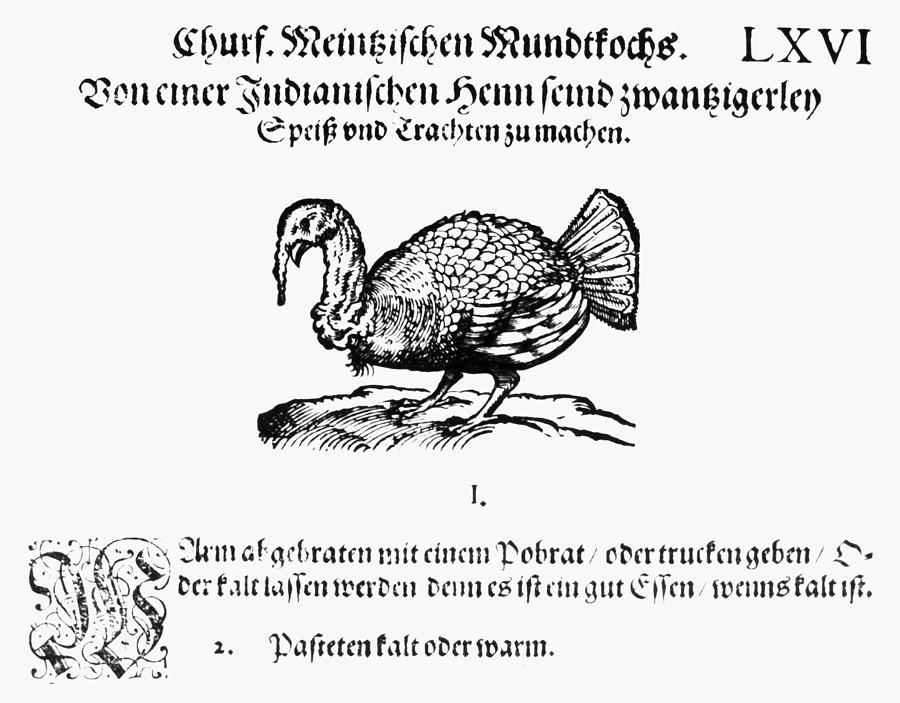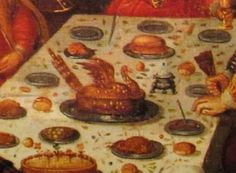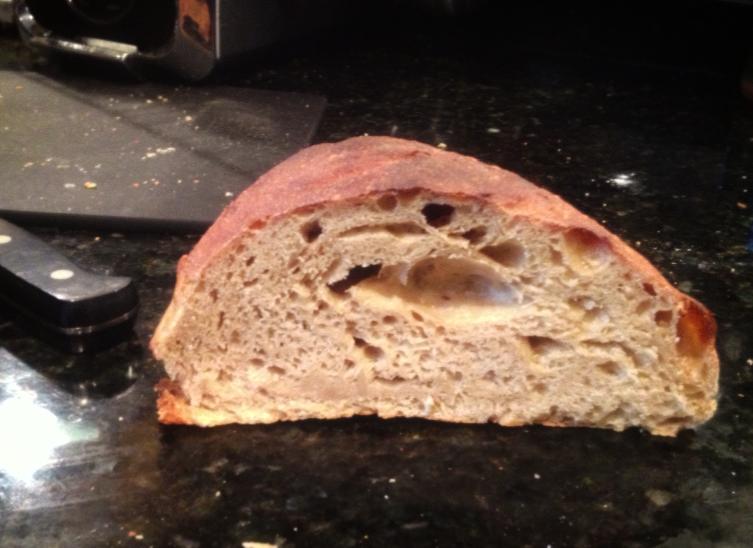What, Where, When:
- This subtlety of turkey cooked in a rye crust is based on German sources from 1581 and 1553.
- It is based on recipes from Rumpolt and Welserin.
Original Recipes and Translations: Rumpolt
(translated by Sharon Palmer)
Von einer Indianischen Henn seind zwantzigerley Spei vnd Trachten zu machen.. [cut for brevity]
Indianischen Henn 2. Pasteten kalt oder warm
Of a turkey there are twenty dishes to make… [cut for brevity]
2. Pies cold or warm..
Pasteten 38. Indianische Hennen gespickt mit Zimt vnd Nelken/ treib darzu ein Pasteten aud mit einem Ruckenteig/ vnd leg den Indianischen Han hinein/ besträw jn wol mit Pfeffer/ Nelken vnd Saltz/ schneidt Speck fein dünne vnd breit/ vnd beleg den Han in der Pasteten damit/ daß du jhn nicht spicken darffst/ machs zu/ vnd scheubs in Ofen/ laß backen/ vnd kalt werden/ so wirt es auch gut.
Pie 38. Indian chicken (turkey) sprinkled with cinnamon and cloves/ drive a pie out with a rye dough/ and lay the Indian cockerel in it/ sprinkle it well with pepper/ cloves and salt/ slice bacon nicely thin and wide/ and lay over the hen in the pie with it/ that you need not lard it/ close it/ and push it in (the) oven/ let bake/ and become cold/ so it also becomes good
Pasteten 34. Nimm junge Hünner/ klopff vnd quell sie im Wasser/ säubers auß/ vnd treib ein Pasteten darzu auff von weissen Teig/ schneidt gesaltzen Limonen fein breit darein/ gib auff den Boden klein gehackte Speck/ mit grünen wolschmeckenden Kräutern/ thu auch Saltz vnd Jngwer darein/ machs zu/ vnd scheubs in Ofen/ Wenns gebacken ist/ so schneidts auff/ vnd geuß ein saure Brüh/ die mit Eierdottern vnd Agrastbeer ist angemacht/ darein/ vnd gibs warm auff ein Tisch.
Pie 34. Take young hens/ beat and parboil them in water/ clean off/ and drive a pie there to from a white dough/ slice salted lemon nicely wide in it/ give on on the bottom small chopped bacon/ with green well tasting herbs/ put also salt and ginger in it/ close/ and push it in (the) oven/ when it is baked/ then cut open/ and pour in a sour broth/ that is prepared with egg yolks and Agrast berries/ and give warm on a table.
Pasteten 41. Haselhüner Pasteten kalt gespickt mit Zimt vnd Nelken/ treib ein Pasteten auff von Ruckenteig/ vnd mach die Haselhüner darein/ wurz vnd saltz sie/ schneidt Speck fein breit vnd dünn/ machs zu/ vnd scheubs in Ofen/ backs/ mach den Kopf/ Flügel vnd Schwanz/ darüber/ vnd laß kalt werden.
Pie 41. Grouse pie cold sprinkled with cinnamon and cloves/ drive out a pie from rye dough/ and wrap the grouse in it/ season and salt them/ slice bacon nicely wide and thin/ close/ and push it in (the) oven/ bake/ place the head wings and tail over it/ and let become cold.
Original Recipes and Translations: Welserin
(translated by Valoise Armstrong)
To make a pastry dough for all shaped pies. Take flour, the best that you can get, about two handfuls, depending on how large or small you would have the pie. Put it on the table and with a knife stir in two eggs and a little salt. Put water in a small pan and a piece of fat the size of two good eggs, let it all dissolve together and boil. Afterwards pour it on the flour on the table and make a strong dough and work it well, however you feel is right. If it is summer, one must take meat broth instead of water and in the place of the fat the skimmings from the broth. When the dough is kneaded, then make of it a round ball and draw it out well on the sides with the fingers or with a rolling pin, so that in the middle a raised area remains, then let it chill in the cold. Afterwards shape the dough as I have pointed out to you. Also reserve dough for the cover and roll it out into a cover and take water and spread it over the top of the cover and the top of the formed pastry shell and join it together well with the fingers. Leave a small hole. And see that it is pressed together well, so that it does not come open. Blow in the small hole which you have left, then the cover will lift itself up. Then quickly press the hole closed. Afterwards put it in the oven. Sprinkle flour in the dish beforehand. Take care that the oven is properly heated, then it will be a pretty pastry. The dough for all shaped pastries is made in this manner.
Discussion:

- Rumpolt is a German source dated to 1581 (Holloway 15), which means many of the techniques and certain ingredients used are Renaissance in nature rather than medieval. For instance, the use of turkey in no less than 24 recipes! Though referred to as “Indian Hen”, the woodcut included in the 1604 edition of the book leaves no doubt that the recipe is in fact for turkey (Maggie).
Further correlation that these recipes really were for turkey (Meleagris gallopova) is found in Food and Health in Early Modern Europe: “In sixteenth-century Europe the Central American bird we call the turkey was known as pavo de las Indias in Spanish, coq d’Inde in French, gallo d’India in Italian and indianischer Hahn in German.” (Gentilcore 140). Gentilcore goes on to explain that even in period they were often confused with guinea hens or with peacocks (141-142). According to DeWitt, the turkey had become fairly common place in the French court by the 1540s (cheaper than peacock!) and spread to the rest of Europe soon thereafter, appearing in German and Italian cookbooks in 1580 and after.  Although the shaped pie recipes included in Rumpolt indicate to place the actual head, wings and tail of the bird on top of the shaped pie, similar to this post-period painting, I’ve chosen to construct them out of pastry for food safety reasons, not to mention my inability to source a fully-intact bird to remove them from. I believe this illustration shows a similar pastry bird, although I have not yet tracked down a source or date for the illumination.
Although the shaped pie recipes included in Rumpolt indicate to place the actual head, wings and tail of the bird on top of the shaped pie, similar to this post-period painting, I’ve chosen to construct them out of pastry for food safety reasons, not to mention my inability to source a fully-intact bird to remove them from. I believe this illustration shows a similar pastry bird, although I have not yet tracked down a source or date for the illumination.

- There is no pastry dough recipe in Rumpolt, although he often specifies rye dough; I’ve chosen to use the hot water and egg method described in Welserin to make a sturdy dough that can be shaped into a free-standing pie and decorations. The pastry is half wheat flour for gluten formation and half rye for preservative properties (rye bread can last 2x as long as wheat) and inexpensive nature in period – this dough may or may not have been eaten, only used as a cooking vessel. That said, other images show great pies with missing crusts, implying they were eaten, but contemporaneous sources refer to rye crusts as coarse, tough, and valued for their longevity.
- I chose to cut my turkey into pieces in order to make it fit more neatly within the pie shape, and for ease of serving and eating. I did not add any sauce to the meat, however, merely salting, spicing, and adding bacon, since the pie was intended to be served cold. Throughout Rumpolt’s chapter on pies, all of the pies with sauces added during cooking are intended to be served “warm to the table” while those without are served cold.
- I have read conflicting sources regarding whether great crust pies were par-baked before filling; in this case I wanted to set the pie crust into shape before adding the meat in order to not over-cook the filling nor allow the crust to slump (This was only moderately successful.).
- This pie is very good using smoked turkey as the filling; however, smoking doesn’t appear to be appropriate for medieval bacon or other meats (de Courcy).
Turkey Pie
Turkey pie with “head”, “wings” and “tail” constructed from hot-water pastry.
Ingredients
- Pastry
.75 cups fat – half lard, half butter
4 eggs, beaten
2 cups wheat flour
2 cups rye flour
2 tsp salt
- Filing
2 lbs turkey breast
½ lb bacon
2 tsp salt
1 tsp ground cinnamon
1 tsp ground pepper
¼ tsp cloves
- Assembly
1 egg, beaten with 2 tbs water and enough flour to form “glue”
Directions
- Make Pastry
- Boil lard and/or butter – about 3/4 cup total – with about 1/4 cup of water.
- While that’s boiling, mix beaten eggs with flour and salt. Pour in boiling liquid all at once, work quickly into dough, kneading until smooth with additional flour or liquid as needed. Make coffyns and decorative pastry work while still warm to avoid cracking.
- Bake Coffyn
- Fill coffyn with flour.
- Add lid.
- Place decorative pastry work on cookie sheet
- Bake coffyn and decorations at 425° until _just_ barely set.
- Make Filling
- Dice turkey breast (½” dice)
- Slice bacon into lardons.
- Mix spices, and salt with turkey.
- Assemble Pie
- Remove flour from cooled crust.
- Add half of lardons in an even layer to bottom of crust.
- Place turkey on top of bacon, then cover with a layer of the remaining bacon.
- Replace lid on coffyn and add decorative pastry work – use beaten egg as “glue” and to glaze.
- Bake Pie
- Bake at 350° until meat is fully cooked – carefully take temperature through crust, turkey should be at least 160°.
